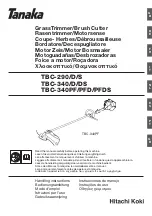
17
Attachmen
DO NOT Trim
You MAY Tri
Trimmer / Nylon
Head
• Grass
• Lawn Edges
• Borders
• Pasture
• Shrubs
• Trees
Brushcutter Blade
• Grass
• Pasture
• Ferns, Weeds,
Light Growth
• Lawn Edges
• Shrubs
• Trees
WARNING
A worn, damaged, or cracked blade
can break, and pieces of the damaged blade can
become dangerous projectiles. A dull blade is more
likely to snag and thrust (kickback). Inspect the
blade regularly, and do not operate the trimmer with
a dull, damaged, or worn blade.
Figure 22
OPERATION
Trimmer Operation
Operating Position
Hold the trimmer firmly with both hands, with your
fingers and thumbs encircling the handles (Figure 22).
This will help keep the trimmer under control at all
times.
• Keep fi rm footing and balance.
• Do not overreach.
• Keep the cutting attachment below waist level.
• Keep all parts of your body away from the rotating
cutting attachment and hot surfaces.
Using a Nylon Trimmer-Line Head
Refer to the chart on this page for appropriate line-
cutting applications.
Line must be released with the trimmer-line head
spinning rapidly.
1. Hold the rotating cutting head horizontal to the
ground.
2. With the engine running at full speed, tap the
cutting-line head on hard, bare ground. Do not tap
the cutting-line head on pavement or concrete.
3. Each tap releases about two inches of line.
4. The blade on the deflector trims surplus line to correct
length. Avoid tapping the head more than once.
NOTE:
Line feed will only operate if both lines still have
a minimum length of 1” (2.5 cm).
Using Brushcutter Blade
Refer to the chart on this page for appropriate blade
applications.
The blade supplied with the trimmer has a protective
cover surrounding the edge of the blade. For your
safety, and to protect the blade, the cover should be
installed whenever the trimmer is not in use or when
installing the blade.
Be sure to remove the blade cover before starting the
engine, or the blade cover may fly off at high speed.
Thrown Debris
The trimmer/brushcutter will throw debris in the direc-
tion of blade movement at the point of contact.
The cutting line head or blade rotate counterclockwise,
as viewed from the operator’s position.
• Tilting the cutting head to the right will throw debris
away from you.
• Tilting the cutting head to the left will throw debris
towards you.
• If the cutting head is held parallel to the ground,
debris will scatter in all directions, and there will be
greater friction which will wear out the cutting line or
blade sooner.
Summary of Contents for BP33-W
Page 24: ...24 NOTES ...
Page 27: ...27 ...











































